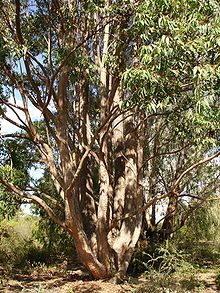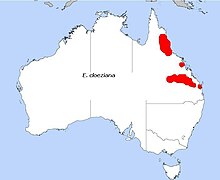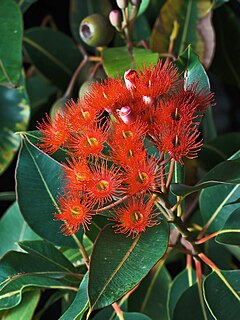
Corymbia ficifolia, commonly known as the red flowering gum, is a species of small tree that is endemic to the south-west of Western Australia. It has rough, fibrous bark on the trunk and branches, egg-shaped to broadly lance-shape adult leaves, flower buds in groups of seven, bright red, pink or orange flowers and urn-shaped fruit. It has a restricted distribution in the wild but is one of the most commonly planted ornamental eucalypts.

Eucalyptus microcorys, commonly known as tallowwood, is a species of medium to tall tree that is endemic to eastern Australia. It has rough, fibrous or string bark on the trunk and branches, lance-shaped to egg-shaped adult leaves, flower buds in groups of seven or nine, white to lemon-yellow flowers and conical fruit. It grows in forests near the coast of Queensland and New South Wales.

Corymbia abergiana, commonly known as range bloodwood or Rockingham Bay bloodwood, is a species of tree that is endemic to Queensland. It has rough bark on the trunk and larger branches, smooth bark on the smaller branches, lance-shaped adult leaves, flower buds in groups of seven, creamy white flowers and barrel-shaped fruit with a very thick rim.

Eucalyptus youngiana, commonly known as large-fruited mallee, Ooldea mallee and yarldarlba, is a species of mallee, less commonly a tree, that in native to arid and semi-arid areas of southern Western Australia and South Australia. It has rough, fibrous bark on some or all of the trunk, smooth bark above, lance-shaped adult leaves, flower buds in groups of three, red, pink or bright yellow flowers and short, broad, conical fruit.

Eucalyptus megacarpa, commonly known by its Noongar name of bullich, is a species of robust mallee or small to medium-sized tree with a scattered distribution in the forests of the south-west of Western Australia. It has smooth bark throughout, lance-shaped to curved adult leaves, flower buds in groups of three, white flowers and cup-shaped, bell-shaped or hemispherical fruit.
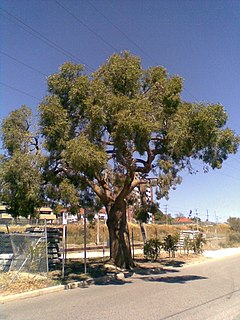
Eucalyptus todtiana, commonly known as coastal blackbuttpricklybark or dwutta, is a species of tree or a mallee that is endemic to the west coast of Western Australia. It has rough, fibrous and flaky bark on the trunk, smooth bark on the branches, lance-shaped adult leaves, flower buds in groups of between seven and eleven, white flowers and cup-shaped to hemispherical fruit.

Eucalyptus salmonophloia, commonly known as salmon gum, wurak or weerluk, is a species of small to medium-sized tree that is endemic to Western Australia. It has smooth bark, narrow lance-shaped to curved adult leaves, flower buds in groups of between nine and thirteen, creamy white flowers and hemispherical fruit.

Eucalyptus pellita, commonly known as the large-fruited red mahogany, is a species of medium to tall tree that is endemic to north-eastern Queensland. It has rough, fibrous or flaky bark on the trunk and branches, lance-shaped to egg-shaped adult leaves, flower buds in groups of seven, white flowers and cup-shaped to conical fruit.

Angophora subvelutina, commonly known as the broad-leaved apple, is a species of tree that is endemic to eastern Australia. It has rough bark on the trunk and branches, lance-shaped to egg-shaped or elliptical adult leaves, flower buds in groups of three or seven, white or creamy white flowers and ribbed, cup-shaped fruit.

Eucalyptus serraensis, commonly known as the Grampians stringybark, is a species of small tree or mallee that is endemic to the Grampians in Victoria, Australia. It has rough, stringy, fibrous or flaky bark on the trunk and sometimes also the branches, smooth bark above, lance-shaped to egg-shaped or round adult leaves, sessile flower buds in groups of three or seven, white flowers and hemispherical or cup-shaped fruit.

Eucalyptus planchoniana, commonly known as the needlebark stringybark or bastard tallowwood is a species of small to medium-sized tree that is endemic to eastern Australia. It has rough, stringy bark on the trunk and larger branches, lance-shaped to curved adult leaves, flower buds in groups of seven, white flowers and cup-shaped, cylindrical or barrel-shaped fruit.

Eucalyptus baileyana, commonly known as Bailey's stringybark, is a tree endemic to near-coastal areas of eastern Australia. It has rough, stringy bark on its trunk and main branches, lance-shaped adult leaves, flower buds in groups of seven, white flowers with stamens in four bundles and urn-shaped to more or less spherical fruit.
Eucalyptus retinens, commonly known as Hillgrove box, is a species of tree that is endemic to the Northern Tablelands of New South Wales. It has rough, fibrous or flaky bark on the trunk and larger branches, smooth bark on the thinner branches, lance-shaped adult leaves, flower buds in groups of seven, white flowers and cup-shaped, cylindrical or hemispherical fruit.

Eucalyptus rudderi, or Rudder's box, is a species of tree that is endemic to northern New South Wales. It has rough fibrous or flaky bark on the trunk and branches, lance-shaped adult leaves, flower buds in groups of seven, white flowers and barrel-shaped or hemispherical fruit.

Eucalyptus cooperiana, commonly known as the many-flowered mallee, is a species of mallee that is endemic to an area along the south coast of Western Australia. It is described as being "of striking appearance by reason of its smooth, white bark and acutely angled branchlets". It has lance-shaped adult leaves, flower buds in groups of between nine and thirteen or more, creamy yellow flowers and urn-shaped fruit.

Eucalyptus longicornis, commonly known as red morrel, morryl, poot or pu, is a species of large tree that is endemic to the south-west of Western Australia. It has rough, fibrous, fissured bark on the trunk, smooth greyish bark above, flower buds in groups of seven or more, white flowers and shortened spherical fruit.
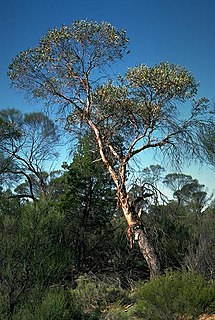
Eucalyptus oldfieldii, commonly known as Oldfield's mallee, is a species of mallee or tree that is endemic to Western Australia. It has a sprawling or spreading habit, mostly smooth greyish or brownish bark, lance-shaped adult leaves, flower buds in groups of three, white flowers and conical, cup-shaped or hemispherical fruit.

Eucalyptus rameliana, commonly known as Ramel's mallee, is a species of low growing mallee that is endemic to desert areas of central Western Australia. It has smooth bark, broadly lance-shaped to egg-shaped adult leaves, flower buds arranged singly in leaf axils, pale yellow flowers and flattened, pyramid-shaped fruit.

Corymbia watsoniana, commonly known as the large-fruited yellowjacket, is a species of tree that is endemic to Queensland. It has rough, tessellated bark on the trunk and branches, egg-shaped to broadly lance-shaped adult leaves, flower buds in groups of seven, creamy white flowers and barrel-shaped or urn-shaped fruit.
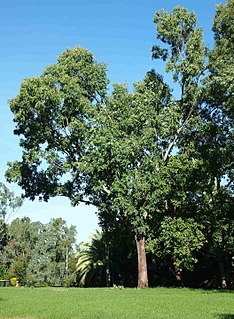
Eucalyptus raveretiana, commonly known as the black ironbox, is a species of small to medium-sized tree that is endemic to Queensland. It has rough, fibrous or flaky bark on the trunk and larger branches, smooth pale grey bark above, lance-shaped leaves, flower buds in groups of seven on a branched peduncle, white flowers and small, hemispherical fruit.
